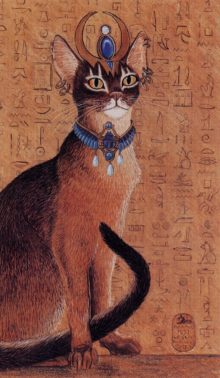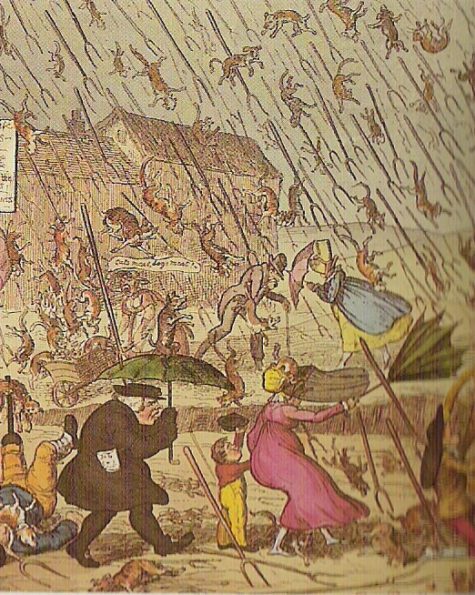Monthly Archives: June 2017
Blackberry Kittens
In Sussex, and some other counties in England, a kitten born just after Michaelmas (September 29), when the blackberry season has ended, is called a blackberry-cat and is expected to be extremely mischievous in its youth.
The same tradition applies to other young animals born at this time, and seems to be connected with the legend of the Devil’s fall to Earth at Michaelmas and his spoiling of the blackberries then and ever since.
Source: The Encyclopedia of Superstitions
Cat Symbolism and Lore
Even the most common household cat has a mystique about it and the potential for the supernatural powers that man has ascribed to cats for thousands of years.
At various times, and in different places, it has been regarded as a holy or a diabolical beast, as a bringer of good fortune or as an omen of evil. In antiquity it was sacred to more than one divinity.
Artemis / Diana, the Goddess of the Hunt was associated with the cat, also notorious for its hunting skills. The followers of Diana revered cats because they were under her special protection, and because she once assumed that form. So too, in pagan Scandinavia, Freya, the goddess of love and fertility, was associated with them, her chariot was drawn by them.
Typically, in Western civilizations, the cat (particularly if it is black) belongs to the witch; it is her familiar, her companion and her alter ego. As such, the cat shares magickal secrets and arcane knowledge which, of course, she cannot explain to mere mortals, since they don’t speak her language. There is an unspoken communication between the witch and her grimalkin that transcends any language used by other creatures.
In the Saga or Eric the Red, there is a very complete description of a witch or prophetess that was a mistress of rune-craft, the art of reading the runes. Part of the description of her costume includes a hood “lined with white cat skin” and “cat-skin mittens.”
When it sleeps, the cat curls itself into a circle with its head touching its tail, making a shape that is very similar to the ouroboros. Like this ancient mythical creature, the cat is a symbol of immortality.
 The Ancient Egyptians regarded the cat so highly that they revered it as a deity. The Egyptian Bast, or Pasht, was cat-headed and attended by cats, and consequently every member of the cat family was loved and venerated in ancient Egypt. To kill one was sacrilege. When a household pet died, its owner shaved off his eyebrows as a token of mourning and performed funeral rites for it.
The Ancient Egyptians regarded the cat so highly that they revered it as a deity. The Egyptian Bast, or Pasht, was cat-headed and attended by cats, and consequently every member of the cat family was loved and venerated in ancient Egypt. To kill one was sacrilege. When a household pet died, its owner shaved off his eyebrows as a token of mourning and performed funeral rites for it.
Bast was the cat goddess, and mortal cats whose fur was of three different colors, or who had eyes of different shades were honored in particular for their Bast-like appearance; it is not just the black cat that holds power. Bast is often depicted with a knife in her paw, having beheaded Apophis, the enemy of the Sun.
Egyptian priests believed that cats carried the magnetic forces of nature and so close proximity to the creatures enabled them to access these powers. If a cat died a natural death in the home, the Egyptians would shave their eyebrows as a sign of mourning.
It was in ancient Egypyt that the belief began that a black cat crossing your path brings good luck. The opposite tradition began in the Middle Ages in Europe.
Cats fared badly during the dark times of the Middle Ages because of the association between witches and cats. Black cats were believed to be witches in disguise. An alternative belief was that after seven years of service to a witch, a black cat would turn into a witch. Consequently, a black cat crossing your path was an indication of bad luck, as the devil was watching you.
The cat does not an honorable reputation in the Buddhist tradition either. Because it was absent at the physical death and spiritual liberation of the Buddha, it is viewed with suspicion as a base, earthly creature, lacking respect, which really should have been present at such an auspicious occasion. The only other creature that was not there was the serpent.
The link between the cat and the serpent comes in the Kabbalah, too, and also in Christianity; in pictures where the cat appears at the feet of Christ it carries the same negative imagery as the snake.
In Islam, cats are regarded favorably unless they are black, in which case they are viewed with great suspicion since djinn can transform themselves into black cats. Additionally, the magical powers of the cat are ambivalent, used either for or against man, this refers to the indifference with which a cat treats its prey.
In the Western tradition of cat lore, the animal has nine lives, whereas its Eastern cousin has to manage with only seven.
A Persian belief about the cat echoes the idea of the witch with her familiar. Some people are born with a hemzad, a spirit that accompanies the person throughout his or her life and takes the form of a cat. That its blood is particularly powerful for writing charms further underlines the universally “magical” nature of the cat.
In Africa, too, the clairvoyant powers of the animal are renowned, and so medicine bags made of cat skin are imbued with supernatural powers.
Interestingly, the cat is not in the Chinese Zodiac. One folktale explanation is that heard Buddha saw Cat playing with mice for fun and did not allow that kind of sin into the zodiac.
Another folk story tells that Cat and Rat were the worst swimmers in the animal kingdom. Although they were poor swimmers, they were both quite intelligent. To get to the meeting called by the Jade Emperor, they had to cross a river to reach the meeting place. The Jade Emperor had also decreed that the years on the calendar would be named for each animal as they arrived to the meeting.
Cat and Rat decided that the best and fastest way to cross the river was to hop on the back of Ox. Ox, being naive and good-natured, agreed to carry them both across. Midway across the river, Rat pushed Cat into the water. Then as Ox neared the other side of the river, Rat jumped ahead and reached the shore first. So he claimed first place in the competition and the zodiac.
Collected from various sources
Raining Cats and Dogs
Where does the expression “Raining Cats and Dogs” come from?
Some authorities tie the idea to Norse mythology. Odin, the Viking god of storms, was often pictured with dogs and wolves, symbols of wind. Witches, who supposedly rode their brooms during storms, had black cats, which became signs of heavy rain. Therefore, “raining cats and dogs” referred to a storm with wind (dogs) and heavy rain (cats).
While the story sounds good, the expression didn’t become popular until the 1700s, when Jonathan Swift (author of Gulliver’s Travels) used it in a satire. He pictured snobby upper class aristocrats solemnly fretting that it would “rain cats and dogs”. Suddenly the saying caught on. Apparently, the English spent a lot of time chatting about rain and it was the latest hit phrase.
More recently, this bit of contemporary “folklore” distributed in a hoax email put forth the following idea, which has since been disproved:
In the 1500’s, houses had thatched roofs – thick straw, piled high, with no wood underneath. It was the only place for animals to get warm, so all the pets… dogs, cats and other small animals, mice, rats, bugs lived in the roof. When it rained it became slippery and sometimes the animals would slip and fall off the roof. Hence the saying, “It’s raining cats and dogs.”
Source: Almanac.com







